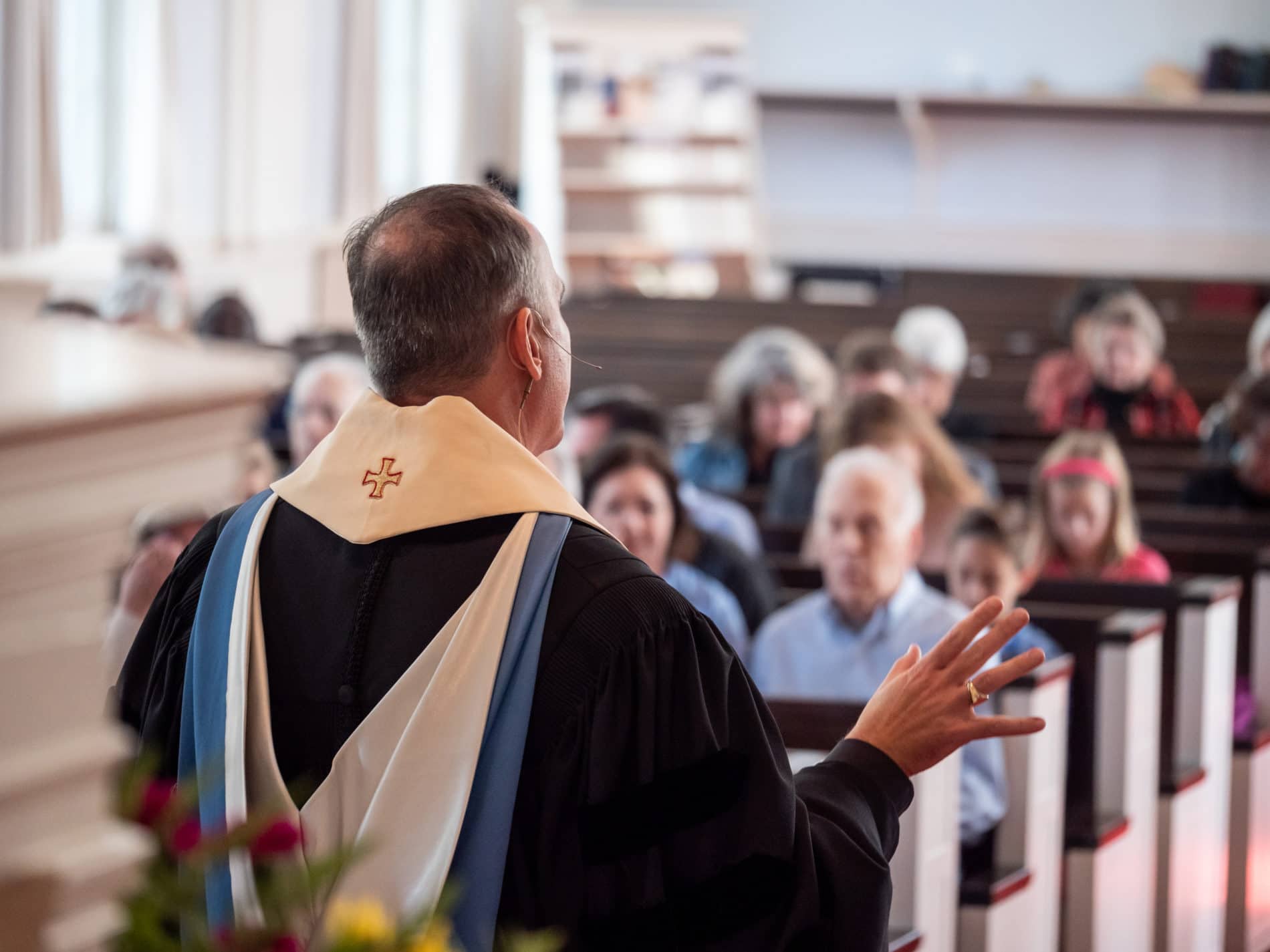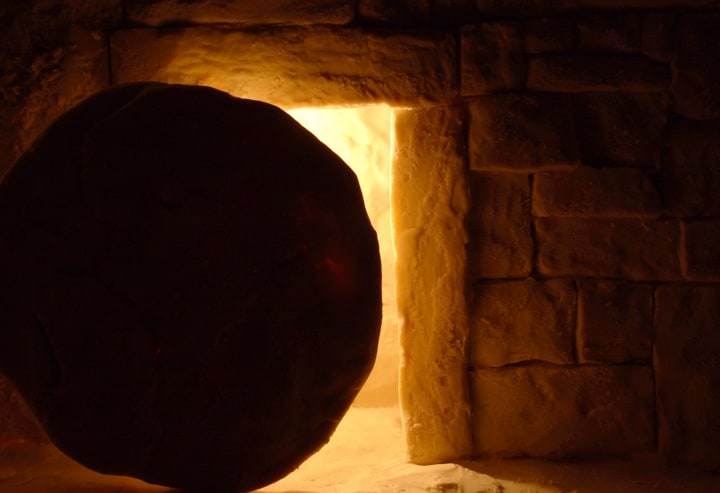
Sermons
Seeing is Believing
April 9, 2023
Matthew wants us to see what the first eyewitnesses at the tomb saw that morning. Earlier in his Gospel, Jesus said, “The reason I speak to them in parables is that ‘seeing they do not perceive, and hearing they do not listen, nor do they understand’” (Mt. 13:13). Some see and others do not. But Matthew wants us to perceive, see, hear, and understand what the two Marys experienced that morning. And it’s the eye that leads them.
Matthew tells us on the first day of the week, on Sunday, they went to “see the tomb” (Mt. 28:1). That’s all. They just want to see it. And what they saw that morning was not what they expected to see or feel. An earthquake shakes them out of their stupor. God’s messenger descends, rolls the stone away, and sits on it. Pilate’s guards—for what surely must be the unluckiest assignment in military history, making sure Jesus stayed in the grave (Mt. 27:62-66)—fearing the sight of the angel, shake and become like dead men. What the guards see generates only fear. The women see the same angel, feel the same earthquake, yet what they see doesn’t culminate in fear because, as the angel said, their sight is conditioned by their hearts’ desire. “Do not be afraid; I know that you are looking for Jesus who was crucified. He is not here; for he has been raised, as he said. Come, see the place where he lay” (Mt. 28:5-6).
Come, see. But don’t linger there long. “Go quickly and tell his disciples, ‘He has been raised from the dead, and indeed he is going ahead of you to Galilee; there you will see him’” (Mt. 28:7). So, they leave the tomb with both fear and great joy. Now expecting to meet him elsewhere, on the way, they meet him. “Greetings!” he says (Mt. 28:9). Did they finally catch up with him out there ahead of them? It’s mysterious and uncanny. They approach him, fall to his feet, and worship him. “Do not be afraid;” Jesus says, “go to Galilee; there [you] will see me” (Mt. 28:10).
That’s the promise. “You will see me.” For Matthew, seeing is central to belief. But what about us who are untimely born, two millennia removed from that morning? In John’s Gospel, Jesus says after Thomas placed his hand in his side, “Have you believed because you have seen me? Blessed are those who have not seen and yet have come to believe” (Jn. 20:29). Perhaps that’s our consolation. We don’t have to see, we say, we can believe; belief is not contingent upon sight.
Perhaps belief is enough. Enough for some, enough for Thomas, maybe, but that seems so rational and abstract.
Belief alone didn’t lead the women to the tomb that morning. They didn’t expect to find the tomb empty. In John’s Gospel, Mary confuses Jesus with the gardener (Jn. 20:15). She doesn’t recognize him at first. Nevertheless, something within draws the women to that place. And it’s that emotion or feeling that should grab our attention; for, that is something we can connect with. It’s their love for Jesus that drew them to the tomb. They just want to be near where his dead body was placed. It’s the heart that leads them to the tomb, moves their feet, directs the object of their gaze, informs what they’re looking for, and allows them to see. Intention is everything. Led by the heart, they’re open to receiving what unfolds before their eyes. Seeing matters.
“He has been raised from the dead,…he is going ahead of you…; there you will see him.” And Jesus said, “There they, [you,] will see me.” There. Out there. Ahead of you. That’s the promise. Matthew wants his church to know, not just believe, but know, sense, experience, feel, and witness. We can be eyewitnesses of resurrection if only we have eyes to see.
What, then, is required for us to see the risen Christ? [1] What is required for us to perceive the risen Christ? For most of the 19th and 20th centuries, theologians believed that historians could help us verify past events. History would lead us to the truth. The Gospels became primary sources for historians, and the church looked to the historian to tell us what was believable or rational; historical facts became the foundation for belief. Other theologians built a wall around the resurrection and said it was not historically verifiable and is, therefore, out-of-bounds for the historian. The search for the historical Jesus always brings us to a dead end. The Gospels were not written as histories but as gospels, gospels that tell the story of God’s good news alive in the world. They tell a story so that we might look for something to unfold in our lives, something of that reality-bending, earth-quaking truth that “Jesus has been raised from the dead, he is not here, but goes ahead of you.” There. Look. Expect to meet him out there ahead of you. With this sense of expectation, we, too, are on the lookout for Jesus-sightings. Seek, and ye will find (Mt. 7:7).
Ahead of you. I remember walking with fear and trepidation into hospital rooms and ICUs early in my ministry, not sure what I was supposed to say or do. Then I learned about something Presbyterian pastor and author Eugene Peterson did throughout his ministry. Whenever he was on his way to the hospital or about to face a difficult pastoral situation, he reminded himself that Jesus was already ahead of him. His prayer was something like this: I know you are already there, Lord, out ahead of me. I pray for eyes to see you and meet you. That became my prayer and remains my prayer. Expectation is required of us to see the risen Christ.
And something else is required. The adage “seeing is believing” is associated with the seventh-century English minister Thomas Fuller (1608-1661). The entire saying is, “Seeing is believing, but feeling is truth.” He points to something we often overlook in our hyperrational and cynical age: ultimately, it’s the heart leads us toward the truth. Affection is required. In the second century, the theologian Origen (c.184 – c.253) said that the “faculties of the heart” must be transformed in our walk with Christ. [2] Contemporary theologian Sarah Coakley stresses, “We ‘perceive’ at different’ levels,’ according to the development of our ‘devoutness.’” [3] It’s the women’s devotion, their hearts set on fire, that leads them to the tomb. It’s the love in their hearts that enables them to be receptive to the resurrection.
To what extent is one’s capacity to see contingent upon the condition of one’s heart?
This question has been stirring in my heart, inspired by one sentence that I came across recently that struck me like lighting. It’s from the notebooks of Ludwig Wittgenstein (1889-1951), the Austrian-born philosopher and mathematician. Wittgenstein was one of the brightest souls of the 20th century. He taught for many years at Cambridge. He’s not easy to read, and I certainly don’t claim to understand him. He spent considerable time reflecting upon the Christian faith and what it means to be a disciple. The sentence is from 1938. This is it: “Only love can believe the Resurrection.” The heart and the soul need something other than certainty or “speculative intelligence,” he said. They will only take us so far. In the end, “It is love that believes the Resurrection,” he wrote. A love that “holds fast” even to the Resurrection. [4] For, you see, love transfigures what we see and believe or believe and then come to see.
The poet Kathleen Raine (1908-2003) had a similar insight. A child of the manse in Scotland, Raine was known for her scholarship on William Blake (1757-1827), who, by the way, had much to say about seeing. Raine said, “Unless you see a thing in the light of love, you do not see a thing at all.” [5]
Love leads us toward the Lord of love. And love leads the Lord of love to us. Love opens our eyes and allows us to see, feel, and know resurrection. And when that happens, and every time it happens, the world is never quite the same. We are never quite the same. And once we see, we cannot unsee. Hearts burning with love allow us to see the risen Christ. For Christ is risen! He is risen indeed! You will see him ahead of you. You will see him there.
And there….
And there…
And here, at the table of Resurrection, the table of bread and wine.

Sources
[1] Sarah Coakley poses this question in her essay, “The Resurrection and the ‘Spiritual Senses’: On Wittgenstein, Epistemology and the Risen Christ,” in Powers and Submissions: Spirituality, Philosophy and Gender (Oxford: Blackwell Publishing, 2002), 130.
[2] Cited in Coakley, 137.
[3] Coakley, 145.
[4] Ludwig Wittgenstein, Culture and Value, trans. Peter Winch (Chicago: University of Chicago Press, 1938), 33e. Here’s the full citation: “What inclines even me to believe in Christ’s Resurrection? It is though I play with the thought. –If he did not rise from the dead, then he decomposed in the grave like any other man…. But if I am to be REALLY saved, – what I need is certainty – not wisdom, dreams or speculation – and this certainty is faith. And faith is faith in what is needed in my heart, my soul, not my speculative intelligence. For it is my soul with its passions, as it were with its flesh and blood, that has to be saved, not my abstract mind. Perhaps we can say: Only love can believe the Resurrection. Or: It is love that believes the Resurrection….”
[5] Cited in John O’Donohue, Anam Cara: A Celtic Book of Wisdom (HarperCollins, 1989), 65.